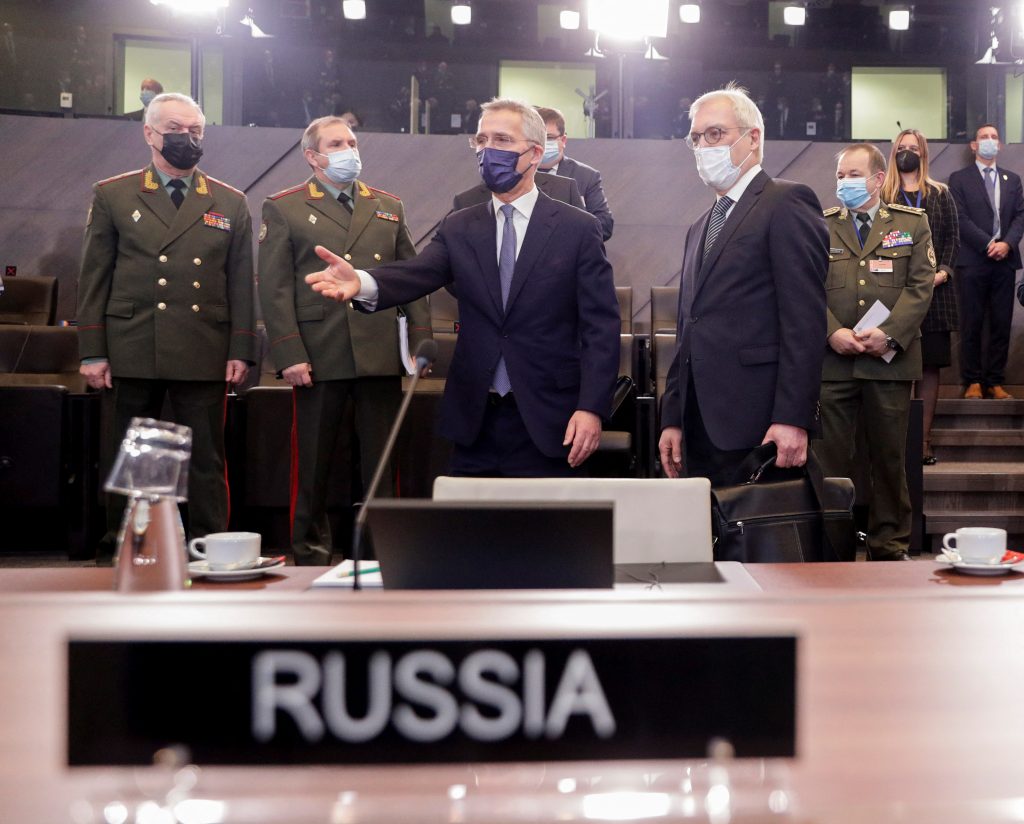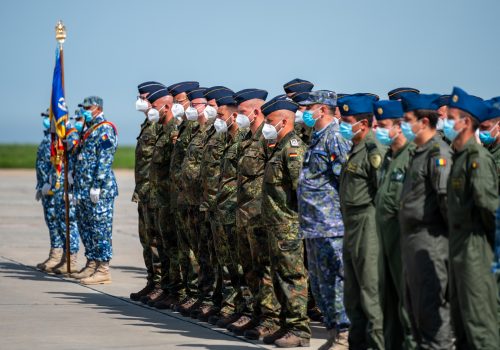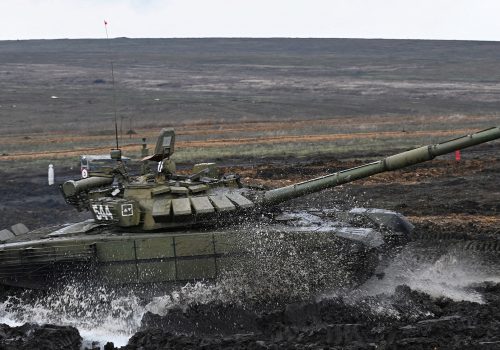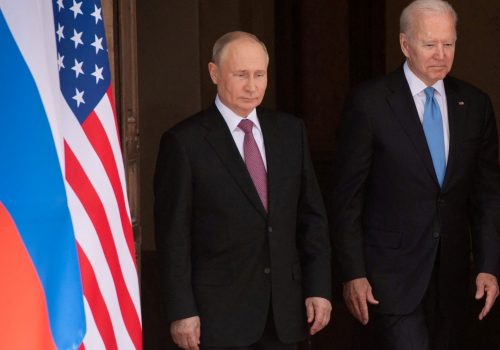Europe sits at the brink of yet another crisis manufactured in Moscow. President Vladimir Putin’s nonstarter-demands of NATO, his one hundred thousand troops along Ukraine’s borders, and hints at measures targeting the United States create a menacing Kabuki theater that could spill into real-world harm in an instant—not just for Ukraine, but for Russia, too.
Putin is not a brilliant strategist: His script has strengthened NATO and its appeal in Eastern Europe. More immediately, NATO allies are already bolstering their force posture; more broadly, Russia’s actions in Georgia and Ukraine have driven both nations closer to the European Union and the Alliance. At this very moment, he is helping reinforce a modern Ukrainian identity that is distinct from Russia’s, and his narrative “on the historical unity of Russians and Ukrainians” has little credence in Ukraine. Recent polling indicates that 58 percent of Ukrainians back accession to the EU and 54 percent want their country to join NATO. Only 21 percent, in contrast, support a customs union with Russia
Ukrainian polls won’t dissuade Putin from menacing Kyiv or NATO, but US and NATO tools are ample—including a very big stick—and responses are likely to be graduated and take three forms: economic sanctions, force posture adjustments, and military assistance for Ukraine. Some recent good news is that with an accomplished US permanent representative, Julie Smith, finally on the job at NATO and Deputy Secretary of State Wendy Sherman leading talks with the Russians, the United States is better placed than it was a few months ago to marshal efforts in Europe against Moscow.
Here’s a menu of options from which the Alliance can choose to mount a robust response:
Part one: technology, consumer goods, and gas
If and when Moscow makes a move, NATO member states can ratchet up pressure. Now is the time for allied deterrent efforts and keeping the door open for talks; it is not a time to make any preemptive military moves that could bolster Putin’s domestic position. However, if Russia interferes in Ukraine, as British intelligence reports suggest is likely, the allies will have no choice but to respond forcefully. Odds are that US President Joe Biden has learned from the Obama administration’s somewhat lackluster response to Russian aggression in 2014, when he was vice president and the administration’s point man on Ukraine.
Expect a heap of additional sanctions on Moscow as a first part of any response. But the track record of sanction effectiveness is limited: Eight years after US and European sanctions were levied for its aggression, Russia still occupies Crimea and supports a simmering conflict in eastern Ukraine. The Europeans are reportedly willing to exclude Russia from the SWIFT network that executes global bank transactions—but the Bank of China has joined Russia’s own domestic version of SWIFT, and the Kremlin has stockpiled dollar and gold reserves. A SWIFT cut would hurt the Kremlin, but it probably wouldn’t kill the regime.
Sanctioning advanced technology sales to Russia would be detrimental to Russia’s domestic armaments and aerospace industries. Such sanctions would also undermine Russia’s ability to compete in the field of artificial intelligence. Another option is to sanction the sale of US-made or -designed consumer goods to Russia. The impact would be broad—including any products that use American-made components—so this option could really pack a punch. The question is: Would the Russian public blame Putin or Biden?
The most potent sanction would be the cancellation of the Nord Stream 2 natural gas pipeline by the new German government. It’s a long shot that remains a possibility due to the Green Party, a key member of the governing coalition. Worries about shutting off gas shipments essential to Western Europe in winter also underscore the danger of relying on a gas supplier like Russia.
Part two: battalions or a ground-fighting force?
In the second part of a NATO response, the allies would likely adjust force posture. Both NATO Secretary General Jens Stoltenberg and Biden have said that NATO’s forward-deployed troop presence—currently four multinational battalions in Latvia, Lithuania, and Poland on a rotational basis—would be increased in response to Russian aggression in Ukraine. What that might mean is purposefully left vague.
If Russia wants a new cold war in Europe, the White House is capable of playing its part. The idea of cutting US troop numbers in Europe in response to this manufactured crisis should be a nonstarter. In the event of another Russian invasion of Ukraine, NATO would most likely commit to deploying additional multinational battalions to the eastern edge of the Alliance. On Monday, the United States proposed sending several thousand troops to Eastern Europe as part of a NATO Response Force. An additional option would be for the United States to make Camp Herkus in Lithuania, which currently hosts a US rotational presence, a permanent base. But a couple additional battalions in the Baltics will not scare anyone in the Kremlin.
So what would? Perhaps redeploying the US 1st Armored Division to Germany. Originally deployed in 1971 to West Germany, this division was based in the reunited Germany until 2011, when it was moved to Fort Bliss, Texas, when the United States and Europe were basking in the so-called peace dividend of the post-Cold War era. Placing this division in Germany would be less hostile than placing it further east, and it would signal a strong US commitment to European security amid its clear focus on the Asia-Pacific region (as a ground-based fighting force, it’s more useful in the European theater anyway). The White House has reportedly generated a graduated list of proportional responses to any Russian action—a very big stick at its disposal that can be utilized if Putin takes further hostile action in Ukraine.
Too aggressive? Sending seventeen thousand US soldiers to a NATO member state is far less threatening than the one hundred thousand Russian troops just east of Ukraine. Even neutral Sweden’s top military officer recently urged such a response.
Part three: lethal weaponry
The third and final part of a NATO response involves sending military assistance to Ukraine. Since the passage of the Ukraine Freedom Support Act in 2014, the United States has been supplying military assistance. The most recent transfers included small arms, munitions, counter-mortar radars, and two refitted former US Coast Guard patrol vessels to buttress the tiny Ukrainian navy, as well as five Mi-17 helicopters to Ukraine (where they had been sent for refurbishing for the Afghan military). Even if they’re released, this assistance won’t do much against a Russian invasion, and NATO military commanders know this. If Russia makes further incursions to Ukraine, more lethal weaponry will be needed.
Additional anti-air and anti-armor assets (such as Javelin missiles to counter Russian T-90 battle tanks) would help, but to really ratchet up the pressure, the United States could sell M109A7 Paladin mobile field artillery to Ukraine. (Estonia is sending Javelins, while Latvia and Lithuania are sending Stinger ground-to-air missiles.) The Ukrainians’ current field artillery, the 2S7 self-propelled howitzer, is dated and outgunned by Russia’s newer 2S7s, which have a better fire control system—not to mention that Moscow has many more of these pieces than Kyiv. Ukraine’s Soviet-made systems are near the end of their life cycle, and to top things off, Ukraine is low on ammunition and unable to produce an adequate supply.
Newer artillery, coupled with unmanned aerial vehicle (UAV) systems, would improve Kyiv’s ability to counter Russia. NATO ally Turkey could sell additional Bayraktar TB2 UAV armed systems to Ukraine in the advent of a hot conflict, building on the good defense industrial relations between Ankara and Kyiv. The sale of Turkish Stand-Off Missiles such as SOM-A and SOM-B1 would also enhance Ukrainian military capability. On the naval front, Britain already agreed to a $1.2 billion loan for the construction of Ukrainian naval assets, and is sending two recently retired Royal Navy minehunters to the Ukrainian navy. In response to Russian aggression, Britain has already sent anti-tank weapons to Ukraine. It can now send the Type 23 frigates HMS Monmouth and HMS Montrose, both of which are slated for early retirement, to Ukraine, further boasting Kyiv’s naval capabilities.
Rejecting an imperial mentality
Russia never intended recent talks with NATO and other European organizations to be fruitful discussions. The Russian mentality with respect to this part of the world is an imperial one: Moscow wants to negotiate over the heads of what it considers to be “lesser states” to settle spheres of interest. The Kremlin wants a return to a nineteenth-century concert of power arrangement; but giving in to Russia’s revisionist approach would be a mistake.
NATO has no obligation to defend Ukraine—but it can and should make any Russian attempts to further annex territory difficult. Ukraine will not join NATO any time soon, if ever, but that does not mean Moscow should be free to bully a former satellite.
Within NATO, the allies have no choice but to robustly enhance their defense posture in response to further Russian aggression. To do less would be disastrous. The credibility of the Alliance, not to mention the United States, would otherwise take a blow. This is something that the Biden foreign policy team seems to understand. But a failure to respond forcefully could also destabilize the status quo in Europe and lead to further Russian advances.
Michael John Williams is a nonresident senior fellow with the Scowcroft Center’s Transatlantic Security Initiative and an associate professor of international affairs at Syracuse University.
Further reading
Tue, Jan 25, 2022
FAST THINKING: The US bets big on NATO to deter Russia
Fast Thinking By
Can the United States convince the twenty-nine other NATO members to support a troop movement in Eastern Europe?
Thu, Jan 20, 2022
Will Russia make a military move against Ukraine? Follow these clues.
Experts react By
Our military fellows from the US Army, Navy, Air Force, and Marine Corps give a sense of the movements from Russia that they're tracking most closely.
Fri, Jan 21, 2022
SpeedRead: The military steps Biden can take to force Putin to back off
New Atlanticist By Jorge Benitez
The White House should deal with the Kremlin-manufactured crisis with the bipartisan strategy that successfully won the Cold War: deterrence.
Image: Russian Deputy Foreign Minister Alexander Grushko and NATO Secretary General Jens Stoltenberg are seen during NATO-Russia Council at the Alliance's headquarters in Brussels, Belgium January 12, 2022. Photo by Olivier Hoslet/Pool via REUTERS



